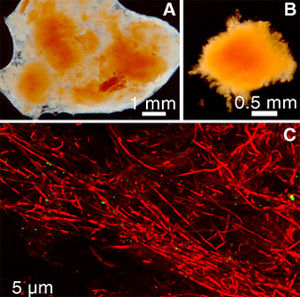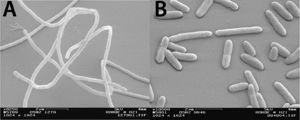Meiothermus: Difference between revisions
| Line 60: | Line 60: | ||
==References== | ==References== | ||
[1] [http://ijs.sgmjournals.org/cgi/reprint/46/2/604 Nobre, M.F., Truper, H.G. and Da Costa, M.S. "Transfer of ''Thermus ruber'' (Loginova et al. 1984), ''T. silvanus'' (Tenreiro et al. 1995), and ''T. chiliarophilus'' (Tenreiro et al. 1995) to ''Meiothermus'' gen. nov. as ''Meiothermus ruber'' comb. nov., ''Me. silvanus'' comb. nov., and ''Me. chilarophilus'' comb. nov., respectively, and emendation of the genus ''Thermus''". "International Journal of Systematic Bacteriology". 1996. Volume 56. p. 604-606.] | [1] [http://ijs.sgmjournals.org/cgi/reprint/46/2/604 Nobre, M.F., Truper, H.G. and Da Costa, M.S. "Transfer of ''Thermus ruber'' (Loginova et al. 1984), ''T. silvanus'' (Tenreiro et al. 1995), and ''T. chiliarophilus'' (Tenreiro et al. 1995) to ''Meiothermus'' gen. nov. as ''Meiothermus ruber'' comb. nov., ''Me. silvanus'' comb. nov., and ''Me. chilarophilus'' comb. nov., respectively, and emendation of the genus ''Thermus''". "International Journal of Systematic Bacteriology". 1996. Volume 56. p. 604-606.] | ||
[] [http://www.genome.jp/kegg-bin/show_pathway?mrb00906 Kanehisa Laboratories. "Carotenoid biosynthesis - Meiothermus ruber". 2011.] | |||
[Sample reference] [http://ijs.sgmjournals.org/cgi/reprint/50/2/489 Takai, K., Sugai, A., Itoh, T., and Horikoshi, K. "''Palaeococcus ferrophilus'' gen. nov., sp. nov., a barophilic, hyperthermophilic archaeon from a deep-sea hydrothermal vent chimney". ''International Journal of Systematic and Evolutionary Microbiology''. 2000. Volume 50. p. 489-500.] | [Sample reference] [http://ijs.sgmjournals.org/cgi/reprint/50/2/489 Takai, K., Sugai, A., Itoh, T., and Horikoshi, K. "''Palaeococcus ferrophilus'' gen. nov., sp. nov., a barophilic, hyperthermophilic archaeon from a deep-sea hydrothermal vent chimney". ''International Journal of Systematic and Evolutionary Microbiology''. 2000. Volume 50. p. 489-500.] | ||
Revision as of 14:47, 17 April 2011

Classification
Domain: Bacteria, Phylum: Deinococcus-Thermus, Class: Deinococci, Order: Thermales, Family: Thermaceae
Species
|
NCBI: Taxonomy |
- Meiothermus chiliarophilus
- Meiothermus cerbereus
- Meiothermus granaticius
- Meiothermus rosaceus
- Meiothermus ruber
- Meiothermus rufus
- Meiothermus silvanus
- Meiothermus taiwanensis
- Meiothermus timidus
Description and Significance

Before the recognition of the genus Meiothermus, the species under the genus Thermus were designated as either high or low-temperature species. The proposal of a new genus Meiothermus in 1996 was made to designate the phylogenetic, phenotypic, and chemotaxonomic distinctiveness of the species that have low optimum growth temperatures. Meiothermus indicates an organism living in a "less-hot" place [1]. The cells are 0.5 to 0.8 μm in diameter and cell length is variable - often forming short filaments. The colonies that form vary from red to yellow pigment and are often found in hydrothermal vents.
Describe the appearance, habitat, etc. of the organism, and why you think it is important.
Genome Structure
Describe the size and content of the genome. How many chromosomes? Circular or linear? Other interesting features? What is known about its sequence?
Cell Structure, Metabolism and Life Cycle

Meiothermus, is a Gram-negative, aerobic microorganism that is variable in length - often forming short filaments. Its common orange appearance stems from the production of carotenoids via the metabolism of tepernoids and polyketides []. It is primarily an oxygenic chemoorganoheterotroph, but some species grow with nitrate as the terminal electron acceptor. As such, it utilizes such organic substrates such as starch, hexoses, pentoses, disaccharides, amino acids, and organic acids as both a carbon and energy source. The optimum growth conditions varies in a moderate temperature range (50-65°C) and alkaline environments (pH ~8.0).
Interesting features of cell structure; how it gains energy; what important molecules it produces.
Ecology and Pathogenesis
Habitat; symbiosis; biogeochemical significance; contributions to environment.
If relevant, how does this organism cause disease? Human, animal, plant hosts? Virulence factors, as well as patient symptoms.
References
[] Kanehisa Laboratories. "Carotenoid biosynthesis - Meiothermus ruber". 2011.
Author
Page authored by Michael Huarng and Steven Huynh, student of Prof. Jay Lennon at Michigan State University.
<-- Do not remove this line-->
